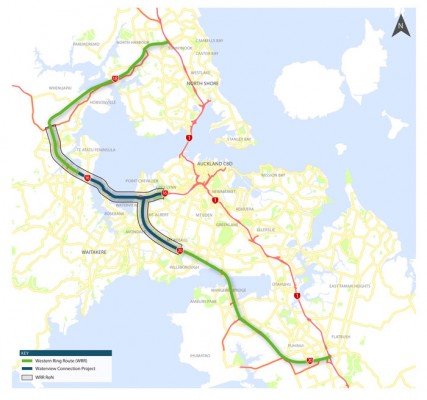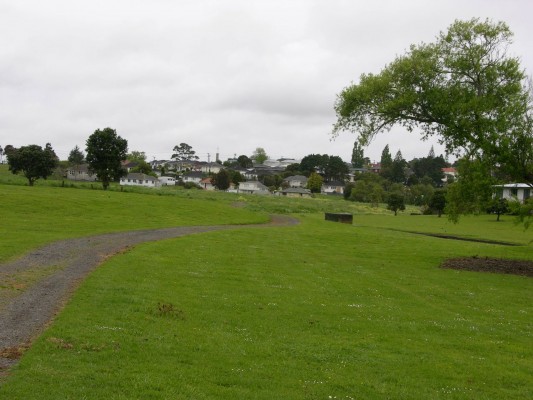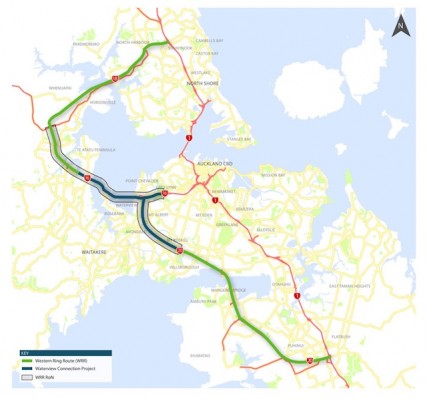Waterview Tunnel Gets Nod
The Waterview tunnel will be built. A draft decision has been given by the Board of Inquiry to grant the NZTA consent to construct the Waterview Connection – the first ever roading project to be considered using the new national consenting process.
NZTA says as a result of the decision, it remains on track to awarding the construction in late August and construction will begin shortly after.
The Environmental Protection Agency has concluded that the Waterview tunnel Project will have substantial transportation and traffic circulation benefits, “but recognises that it is only a part of the overall regional transport picture. ”
As part of the Board of Inquiry’s draft decision some changes have been made to the NZTA’s proposed set of conditions. These changes include moving the location of the ventilation buildings and stacks and additional open space requirements.
“Following considerable assessment we held that there would be potentially severe adverse effects resulting from the proposed (“as lodged”) location of the northern ventilation stack.Mitigation of this effect is to occur by a new location on the eastern side of Great North Road. The support buildings will remain in the originally proposed lodged location on the western side of Great North Road, but are to be constructed in a significantly modified form, with some housing reinstated on the affected section of the Great North Road frontage.A need to protect open space, and concern about visual and amenity effects, has promoted the need to move the southern ventilation building, stack and control buildings a further 70-80 metres to the south east side of the originally proposed location.Considerable work has been done by parties on mitigation of what would otherwise have been severe adverse effects on the Waterview School and Waterview Kindergarten, and moderate adverse effects on other institutions in the subject communities. A number of institutional and corporate parties, and NZTA, are to be commended for ultimately producing detailed agreements ensuring significant avoidance, remediation and mitigation of adverse effects.”
The commission says that the economic benefits claimed by the proponents and supporters of the project resonated with them.
“The economic benefits will very largely be derived at a regional and national level. The costs in terms of reduced amenity and environmental detraction will conversely be borne at a local level by the communities through which the proposed motorway is to pass, albeit that there was evidence of likely creation of jobs in the locality as one would expect.”
It adds that post construction it has “identified strong net social benefits in roading, connection improvements, and economic growth.”
Cycle Action Auckland is thrilled to find the Board of Inquriy decided positively on a cycleway and $8m funding will be provided to build it.
With reference to the submission it said:
“Mr Pitches of the Campaign for Better Transport made an oral representation to the Board, as did Mr M Tritt, a local resident. Both questioned the alleged benefits of the NZTA proposal and expressed a preference for a greater variety of transport options. [175] We were not however able to pay significant regard to the concerns and views of these submitters.
“Our Board is a creature of statute: it has very closely defined powers and duties and these do not extend to enable us to question the designating authority’s objectives, or even its choice of alternatives (except that we must consider whether adequate consideration has been given to alternatives).”
Nor did it accept an argument about fuel prices.
Its report states:
“Campaign for Better Transport submitted that the benefits of the Project had not been properly evaluated in the context of rising fuel prices.
This was, however, a matter that was addressed in the evidence on behalf of NZTA by Mr AP Murray, transportation engineer. He did this by reference to the Traffic Modelling Report in the AEE, Technical report G.25.
It is relevant that the report models fuel prices for 2026, at $2.75/litre, noting that such a value is in real 2026 terms, thereby showing a 77 percent increase over the 2006 fuel price. The benefit cost ratio, as calculated from the ART3 model, utilises that pricing. [183] We note that Campaign for Better Transport did not file any evidence of its own; it simply addressed representations to the Board through its agent Mr Pitches.
So, no sworn evidence was offered, and in particular, the group’s thinking was not put forward in a way that could be tested by cross examination by other parties. Further, Mr Murray was not cross examined by any representative of Campaign for Better Transport. [184] We have no basis for holding that future fuel prices have not already been considered in the modelling and the benefit cost calculations.
On the issues of rail corridor land, the report says:
Issue 1: Inclusion of the rail designation in quantum of existing open space.
It was Mr McKenzie who raised this issue, but all others disagreed with him. He sought to include the presently open green railway corridor in calculating existing open space, thereby demonstrating that there was a greater shortfall in the Project’s open space quantum.
The other experts disagreed because the rail land is not zoned open space, and its future is not guaranteed as such, and any temporary leasing agreements are just that – temporary.
We consider that the majority view is correct. To include the presently open green rail corridor space in overall open space calculation would be too speculative.
Issue 2: Use of future rail corridor land.
This was a topic on which agreement was reached, to the effect that the rail corridor itself, behind Hendon Avenue, is not suitable for public access and should be inaccessible and excluded from open space calculations because it is an isolated strip of land, it is not overlooked, there are concerns about security for people and property, and it is not appropriate to preclude future use of the land for rail.
The experts agreed that while the land would still have an open landscape flavour, the revised UDL plans should signal greater diversity in planting (than flax) within the rail corridor, and that this topic should be delivered through condition OS.2.
Having ourselves inspected the land concerned, and properties surrounding it, particularly in the neighbourhood of the Pak ‘n Save supermarket, we agree.”
The conclusions in its report include in the Board’s words:
- It is acknowledged there will be unavoidable adverse visual and amenity effects on heritage areas located in close proximity to and within the project area. However, after fairly significant attention to conditions of consent, there will be suitable mitigation of the heritage impacts. Likewise, NZTA has worked closely with the relevant parties regarding cultural effects and proposed conditions for ongoing liaison between the parties have been provided for.
- As regards coastal processes we find that, subject to mitigation measures incorporated in the proposal, the short and long term effects will be no more than minor. Effects on marine ecology (other than the additional permanent occupation of space in the CMA are found to be minor to moderate and can be suitably mitigated and monitored through consent conditions.
- Many submissions were received about permanent occupation of the CMA and the consequential reduction of area and habitat loss in the Motu Manawa Marine Reserve. While the effects are significant, it is not within our power to direct an expansion of the reserve in other directions, and we have reached the conclusion that the draft conditions of consent are appropriate for the purpose of avoidance, remedial action, and mitigation of these matters.
- We are in agreement with the outcome of the experts in caucus that freshwater ecology effects can be mitigated to appropriate levels such that the overall ecological effects on freshwater ecosystems would be no more than minor.
The conditions to granting the project are here:
The NZTA now has 20 days to review the draft and provide feedback to the Board, before the Board releases its final decision on 30 June. In parallel with this process, the NZTA is also nearing the completion of the tender process to construct the Waterview Connection Tunnels and Great North Road Interchange.
 NZTA State Highways Manager for Auckland and Northland Tommy Parker says the draft decision marks an exciting and important milestone towards completing the Western Ring Route and unlocking Auckland’s potential for economic growth.
NZTA State Highways Manager for Auckland and Northland Tommy Parker says the draft decision marks an exciting and important milestone towards completing the Western Ring Route and unlocking Auckland’s potential for economic growth.
“This is great news for both Auckland and New Zealand. The NZTA is delighted that the draft decision released by the Board is to give us consent to construct the Waterview Connection. This will be the country’s largest and most complex roading project to date, and it will deliver significant benefits to New Zealand.
“Building the Waterview Connection and completing the Western Ring Route will create a transport solution for Auckland that will improve our state highway network and boost our national economy.”
Completing the Western Ring Route includes constructing the Waterview Connection – which includes two three-lane tunnels – as well as widening and raising the causeway and other capacity improvement works from St Lukes to Westgate.on the Northwestern Motorway (State Highway 16).
The NZTA’s application for designation and resource consent to construct the Waterview Connection was lodged with the Environmental Protection Authority in August last year and referred to a Board of Inquiry soon after. Hearings to consider the application began in February, where the Board considered all the evidence and submissions on the project from the NZTA, local authorities, the community and other interested parties.
Contractors Federation CEO executive Jeremy Sole says that as well as creating a transport solution for Auckland, with all the associated economic benefits, it is also a significant project in terms of showcasing the engineering capability of New Zealand’s civil construction industry.
“It will also provide tremendous opportunities for small to medium sized contracting companies and suppliers who will sub-contract to the consortium that wins the tender process.”
NZTA site about the Project is here














9 Comments
So when is the planned start date on this?
@Cam It is in the post:
NZTA says as a result of the decision, it remains on track to awarding the construction in late August and construction will begin shortly after.
http://www.nzherald.co.nz/nz/news/article.cfm?c_id=1&objectid=10727981
“Expected completion date: End of 2016, with construction due to start before Christmas.”
OK that’s all good that they have got this up and running but what about building the Avondale-Southdowns railway line as well, or at least make some provision for it so when Waterview does get built, Kiwi Rail or what ever company wants to build a rail line there won’t have to do a significant amount of earthworks which will also bring the cost down for constructing the line, thereby making it a reality in the near future.
It will also provide rail access to Mt Roskill if a train station was too be built. The only problem is the project won’t do the above that I’ve mentioned.
They are also planning on spending heaps of money just to widening the motorway between St Lukes and Westgate, which is all well and good but it won’t significantly cut down congestion unless a North-West busway is constructed along the corridor much like the Northern busway.
As it stands it is a complete waste of money as well as a wasted opportunity. NZ needs to get out of the 21st century, this mindframe is holding the country back. The basic “We should have done this years ago attitude!” It just doesn’t work anymore. I have no doubts that when Waterview is finally finished there will still be heaps of congestion where SH20 merges onto SH1 in a very short period of time and we will be back to square 1 again, this time billions of dollars down the drain. If a rapid transport system was built at the same time then it wouldn’t be so bad, provision for rapid transport means shit these days, just like when they built the new Mangere Bridge they could have built a railway bridge alongside but no they made provision for one instead. Surely NZ has the technology to succeed, but not the mind frame unfortunately that’s the only thing that’s holding us back. What do you think Jon C is my argument a good one?
One of the very few roading projects I can tolerate. Happy for it to go ahead.
@BD Separate coverage and debate on that line here http://www.aktnz.co.nz/2011/05/25/protecting-future-avondale-line/
@Shayno The same with me. Projects like but the whole Western Link or Kopu Bridge in the Coromandel - they should and happy to go ahead, otherwise the motorway north of Puhoi not so glad. As the North-western widening - I noticed some talks about the the busway going along this NW motorway up to the CBD, something in style of the North Shore busway, which would be great. Has someone any information about this, to be included in the project once completed in 2016?
Andrej, I can say with pretty good certainty (no proof, but I can’t prove a negative) that that is not the case. Providing a real busway would need a major shift in the way the interchanges, bridges, and indeed, the motorway itself is laid out. This would cost megabucks (which we don’t have, because all our money is being pissed away on car-oriented motorway projects).
The fact that SH16 is getting widening could be about a 25% help to a future busway (assuming one gets NZTA to then release some traffic lane capacity to create the busway on said lanes), but 75% of the work will be in getting separate bridges or underpasses at the interchanges, so buses aren’t stuck in the same congestion as everyone else.
And that is not provided in anywhere in the plans at all. The proposed SH16 widening is all about cars, with a small sop of “bus shoulder lanes” thrown it.
The NW is not designated as an RTN, so NZTA can cheerfully ignore all calls to put in a busway.
But remember National is spending on PT ‘because buses use roads too, you know’.